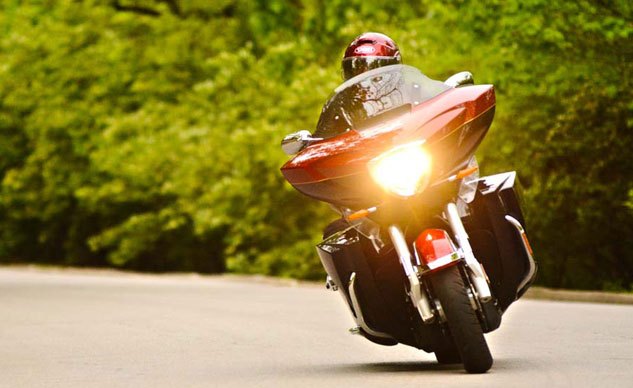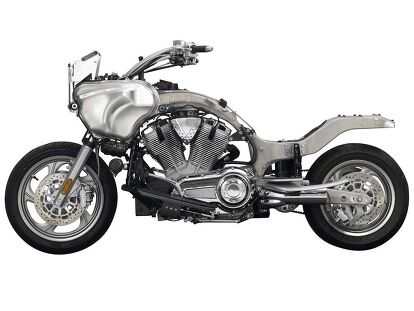2014 Victory 15th Anniversary Cross Country Tour Limited-Edition Review
A 5,000-mile test ride
We already knew Victory‘s Cross Country (and Cross Roads) were great bikes, comparing favorably with their big-inch cruiser rivals since their launch in 2009.
2014 Victory 15th Anniversary Cross Country Tour Limited-Edition
| Engine | 17.0/20 |
| Suspension/Handling | 12.0/15 |
| Transmission/Clutch | 7.5/10 |
| Brakes | 7.5/10 |
| Instruments/Controls | 4.0/5 |
| Ergonomics/Comfort | 9.5/10 |
| Appearance/Quality | 9.0/10 |
| Desirability | 8.0/10 |
| Value | 6.0/10 |
| Overall Score | 80.5/100 |
But you never really know how good a touring bike is until you really get out on the road on it on your own, away from the manufacturer reps and seven-course repasts and down comforters every night. With a little downtime in my schedule due to yet another career realignment, it felt like a good time for a little moto-walkabout – a two-week, 5000-mile loop through Arkansas, up to visit the old homestead in Kansas City, out through Nebraska, then south through Colorado and home again to the OC.
2011 Victory Cross Country Review: Cory Ness Signature Edition
Both “Cross” bikes use the aluminum frame Victory first devised for its Vision in 2007, a great bike with styling that may have been a little ahead of its time for the traditionalist tastes of many buyers of this kind of motorcycle.
That aluminum backbone is a very solid platform that gives the Country a feeling of aircraft-level structural integrity when it’s time to make time. Together with 4.7 inches of air-adjustable suspension at the rear and an inverted cartridge fork up front, this traditionally styled touring bike serves up a highly contemporary ride at speeds its competition can’t really match. I didn’t get east of the Mississippi in the course of this little working vacation on the CC, but now that states like Texas and New Mexico and Arizona have 75-mph speed limits even on many two-lanes, this bike’s ability to shrink vast expanses is really appreciated.
That 1731cc (106 cubic inch) 50-degree V-Twin doesn’t disappoint. It’s not exactly a fire-breather, but then it is being asked to propel a bike that Victory says weighs 845 pounds – and that’s before you put 5.8 gallons of gas in the tank and start filling its massive saddlebags and trunk with ammonite fossils, bottles of wine, buffalo bones, your own middle-aged self, etc.
Early gearboxes were a little long of throw and clunky, but Victory tightened things up for 2011, and this latest model shifts as well as anything in its class, which I suppose is a backhanded way of saying it maintains just a little of the agricultural feel people expect. And maybe agricultural is a good thing; tractors are expected to last forever and do. Service-wise, the Victory’s four valves per cylinder use hydraulic lifters, which means maintenance mostly consists of an oil change every 5000 miles. At the end of my 5000-mile ride, the bike had used about one-half quart of the five its sump holds.
Here’s what went wrong: After a day-and-a-half of frog-strangling rain in Arkansas, the cruise control stopped working. No big deal in Arkansas, because I was on twisty two-lanes nearly all the time. But I knew the ride back west would be a carpal tunnel catastrophe without it. Luckily, when I got out from under the clouds and let the Missouri air blow-dry the unit for about half a day, the cc fixed itself. The control buttons do hang down in the weather, right below the right switchgear. A nice bead of silicone around the unit’s seams might not be a bad idea. Then again, the rain may have been a complete coincidence? Anyway, the cruise control has been working fine ever since.
The gas gauge is a good substitute for a nagging spouse. The needle goes to E and the light comes on when there’s still at least 1.5 gallons in the tank. No biggie; I rely on the tripmeter. The farthest I pushed it was 5.4 gallons and 205 miles. (Capacity is said to be 5.8.)
About once a day, the left side cover would come loose and nudge the inside of my left knee. I’d stop and stick the front two pins back inside their rubber grommets. The rear grommet was missing. The cover would stay in place until the next least convenient time to come loose: Passing a truck while eating a banana. Banked over in a fast sweeper while wondering what happened to all the good XM stations? Have I got the economy package here on a $29,999 motorcycle? Maybe the fix is as easy as a new rubber grommet for the rear pin.
Sometimes, not all the time, the shifter doesn’t want to return to center after you’ve been cruising awhile and want to downshift from sixth. You need to monkey with it quite a bit to get down to the lower gears. Annoying.
The things the bike does well far outnumber those minor failings. Originally I was going to get a new BMW R1200RT for this trek, which would’ve been better in Arkansas and on a couple of mountain passes in Colorado, but for the other 4000 miles of mostly straight and not-so-narrow (and fast), you begin to comprehend why motorcycles that look like this one own the American highway. And off the American highway, I doubt the BMW would’ve gotten nearly as much love from passersby.
For 155-pound me, the Country’s just too large in parking lots and in tight quarters, but at least the seat’s really low, and once rolling and ensconced in its deep dish atop the bike’s 65.7-inch wheelbase, I may be starting to “get it” at last. Those long floorboards give you all kinds of seating options. Now and then you can stand on the passenger ones and do a Leonard Di Caprio “king of the world” full-body stretch out over the bow and let the breeze air out your Aerostich suit.
Your magnetic tank bag’s place atop the steel tank makes it easy to access snacks and your cocktail shaker on the fly – as well as your phone, which gets wired into the sound system and charged inside the left lower’s glovebox. The stereo’s great for listening to NPR when you’re parked and trying to clean all the nooks and crannies after a long ride. At speeds above 70, not so much – though you do get enough volume for a little background music.
You can also reach down and open the vents in the fairing lowers to let air in, as well as a pair of really clever winglets on either side of the main fairing’s lower edge which can either block or direct air right toward you.
At the end of the day (really 16 days and 5,464 miles), I have to say this is one sweet North American motorcycle. I did an 800-mile day and one 900-mile jaunt that lasted about 16 hours, and I actually felt okay at the end of both of them, mostly due to the sheer largeness of the thing that allows you to move around as much as upon your favorite couch, while the continent becomes your big screen TV.
So, $29,999 is a lot of money for this 15th Anniversary Limited Edition, complete with special paint and badging, billet wheels, chrome trim, GPS, etc. But the base model gives you all the essential ingredients, including cruise control, ABS and heated grips and seats, for fully $7500 less. And if you really want to flout convention, the original Victory Vision, still years ahead of its time, is even less expensive.
All of a sudden, I think these are all really underappreciated motorcycles. It should be really interesting to see what Victory comes up with now that Indian’s become Polaris’ “traditional” brand.
More by John Burns














































Comments
Join the conversation
I have ridden several of the Victory tourers (Vision, Cross Country, Cross Country Tour) and can't fault them in any performance area -- good power, good braking, good handling, good on bumpy, twisty roads (although there's noticeable driveline slack, and the faired models fried my short legs). They just didn't put a smile on my face. Some bikes have an indefinable quality that you connect with immediately, and some don't. I rode an Indian Chieftain recently, and I immediately felt good on it, in addition to it having excellent performance.
Anyone know what tank bag the author was using? AND most importantly....it had to interfere with his steering. I have not yet found a good solution for a tank bag for this bike. Suggestions are very welcomed.